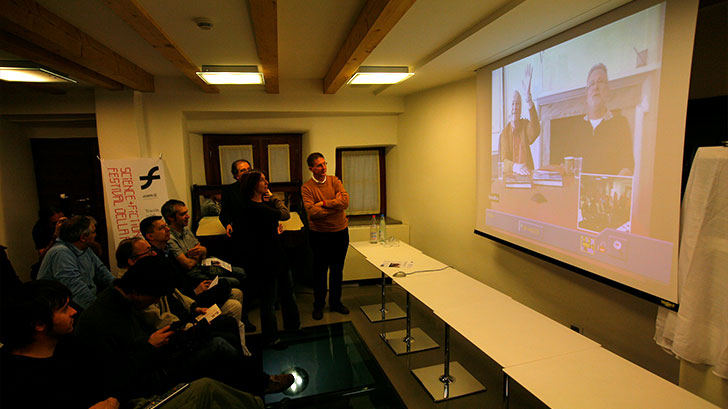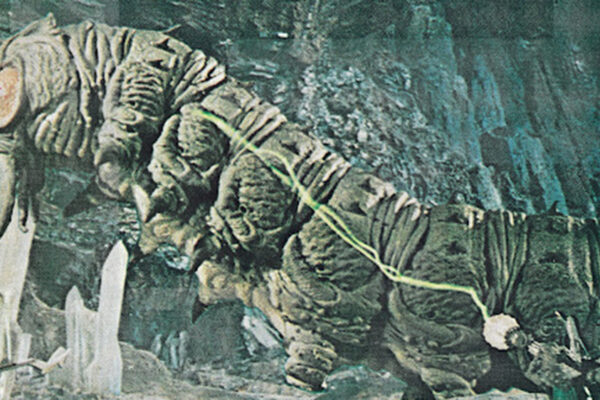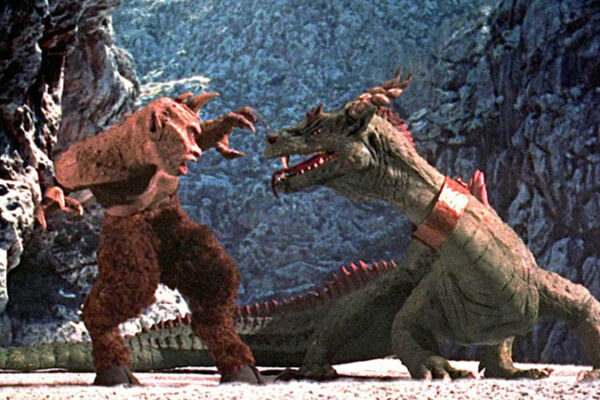
Ray Harryhausen
Premio Urania d’argento 2008
To the delight of cinema audiences the world over, Ray Harryhausen has made dinosaurs walk the earth, horses fly, statues come to life, apes play chess, and skeletons fight. Harryhausen calls his work “kinetic sculpture”; it is a method of stop-motion filmmaking that has made him a cult figure in the world of cinema.
Born in Los Angeles, June 29, 1920, Ray Harryhausen was educated at Audubon Junior High and Manual Arts High School.
School held little interest for him, but at an early age he conceived an overwhelming passion for the film King Kong, a fascination which became the basis of his future life.
“I first saw King Kong by accident,” he has said, “My aunt was a nurse and had been taking care of Sid Grauman’s mother. She was given three tickets for the film and took my mother and myself. I haven’t been the same since.”
Harryhausen became fascinated with the film because he couldn’t determine how it was done. He knew it was not a man in an ape suit and soon learned that the film’s creator was Willis O’Brien. “I was in awe of O’Brien’s ability to produce on the screen the illusion of life.” Harryhausen remarked.
The film inspired Harryhausen to begin experimenting with his own models. The first was a Cave Bear fabricated from his mother’s fur coat. Borrowing a friend’s 16mm camera, Harryhausen made his first attempts at stop-motion photography. The camera was difficult to control, but he says, “the excitement of seeing the bear move was quite satisfying, which encouraged me to do more”. He found that his interest in this form of cinema was so great that he began to look for ways to develop his hobby into a career. To this end, he went to night school at the University of Southern California and studied all aspects of trick photography, from matte shots to double exposure.
Harryhausen established a studio in a corner of the family’s back porch and his father, always encouraging Ray’s ambitions, later built him a studio at the back of the garage. By 1940, he owned his own singleframe camera and had begun work on
his first feature-length film, Evolution, an intricate film based on the origin of the species. Unfortunately for Ray, Disney released Fantasia and he realized there was no point in continuing. He decided the time had come to get a job and showed his footage of Evolution to George Pal.
Pal, who made shorts called Puppetoons, thought Harryhausen’s work brilliant and hired him.
Harryhausen worked with Pal until 1942, when he was drafted into the Army Signal Corps. He was lucky to be assigned to the film unit and spent the war making animated segments for orientation films.
Discharged at war’s end, Harryhausen went back to his garage studio and decided to make a series of fairy tales, beginning with a ten-minute film called Mother Goose Stories. After some setbacks, the film was released by Bailey Films and, with the money he earned, Harryhausen was able to make four more fairy tales.
Ray Harryhausen’s hero remained Willis O’Brien, creator of King Kong. In 1939, he had summoned the courage to telephone O’Brien and arrange a meeting.
O’Brien had been critical of his work, although in a constructive way, but obviously remembered Harryhausen’s talent. In 1946, O’Brien asked Harryhausen if he would like to assist in the production of Mighty Joe Young, the story of an enormous ape. Naturally delighted, Harryhausen moved into the RKO Studios and the film, finally released in 1949, won O’Brien an Oscar.
O’Brien’s next project, The Valley of the Mist, ran into pre-production problems and Ray Harryhausen returned to his fairy tales.
Then a friend introduced him to a producer, Jack Dietz, who wanted to make a monster movie. The Beast from 20,000 Fathoms (1953), Harryhausen’s first feature-length film, was based on long-time friend Ray Bradbury’s story of a dinosaur rising from the sea in answer to a foghorn, thinking it to be a mating call.
A young producer who had worked for Universal and Columbia, Charles H. Schneer wanted to make a picture about a giant octopus that pulls down the Golden Gate Bridge. Called It Came From Beneath the Sea, the film was a success and also marked the foundation of a professional partnership between Schneer and Harryhausen that endured nearly 30 years.
Harryhausen and Schneer produced a trio of films during the height of the science fiction boom of the 1950s including the aforementioned It Came From Beneath the Sea (1955), Earth Vs. the Flying Saucers (1956) and 1957’s 20 Million Miles to Earth.
All of these low-budget, black-and-white films were enlivened by Harryhausen’s developing artistry and innovation within the field of stop-motion animation.
At the end of the 1950s, Harryhausen and Schneer made a distinct break away from science fiction into the fertile world of fantasy, fairy tales, and myth, with their groundbreaking and highly acclaimed The Seventh Voyage of Sinbad. This film was also Harryhausen’s first opportunity to experiment with color, and its success was such that it led to a trilogy of highly popular Sinbad movies, culminating in Sinbad and the Eye of the Tiger in 1977. The late 1950s/early 1960s also saw Harryhausen and Schneer moving their production base from Hollywood to London, where they could utilize the technical expertise of British studios and crews while also being able to film at various exotic European locations, particularly in Spain.
In 1963, Ray produced arguably his most famous film, Jason and the Argonauts, which is also regarded by Harryhausen himself as his most complete film, incorporating as it does much of his most seamless and yet outstanding stop-motion animation in many memorable sequences, not least of which is the famous fight between Jason and the supernatural skeletons of the dead.
During the 1960s, Harryhausen also contributed to notable films such as The First Men in the Moon in 1964, One Million Years BC in 1966 and The Valley of Gwangi in 1969. He finally brought the curtain down on his film career in 1981 with his and Schneer’s Greek mythological epic, Clash of the Titans. In 1992, at the sixtyfourth Academy Awards, Harryhausen was honored with an Oscar for his lifetime of extraordinary achievements.
In 2003, Harryhausen was honored with a star on the legendary Hollywood Walk of Fame; in 2004, his large-format book, Ray Harryhausen: An Animated Life was published; and 2005 saw the release of an elaborate two-disc DVD, Ray Harryhausen: The Early Years Collection, containing all of Harryhausen’s early short films, tests, and experiments.
In February 2008, Ray Harryhausen was honored by The Art Directors Guild at its 12th Annual Awards ceremony for his “Outstanding Contribution to Cinematic Imagery.”
Harryhausen has finished his third largeformat book, written with Tony Dalton, in which they detail the history of stop-motion animation worldwide.






